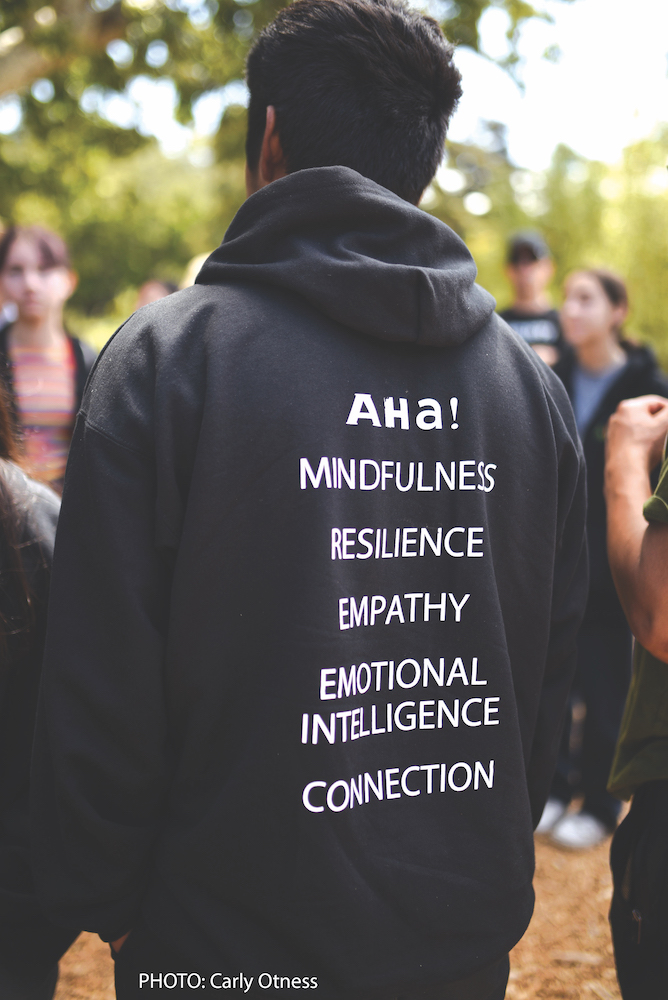AHA!
AHA!’s (Attitude. Harmony. Achievement.) multi-faceted programs have been rapidly expanding nearly a quarter-century after the organization’s founding in response to the shooting at Columbine High School back in 1999. The proof is in the post-pandemic pudding, which emerged late last month when some of AHA!’s after-school programs got underway.
“The demand for what we’re doing has really expanded,” said Melissa Lowenstein, AHA!’s Director of Training. “We have a really packed after-school program. The first meeting of the ALLY group at Santa Barbara High School had 63 kids show up, when we only have room for 29, which is amazing. At San Marcos, there were so many girls who came out for the girls’ group that we had to add a second one. We also have a guys’ group, a new outdoor group, and there’s a Zoom parent group once a month that just had our first meeting last week. We started serving the Montecito Union School District and have a parent group there. And our Littlest Little Farm that used to be at a private home is now at the Nature Lab on the campus at Montecito Union, which more than doubled our capacity for kids.”

That surging success is because the community is increasingly discovering the effectiveness of AHA!’s efforts to equip teenagers, educators, and parents with social-emotional learning (SEL) and intelligence to dismantle apathy, prevent despair, and interrupt hate-based behavior. SEL has shown to have unmatched importance in reducing emotional/physical violence in schools by building healthy campus climates with young people taking on the role of change agents in the shift.
AHA! programs serve middle school, junior high, and high school students, their parents and guardians, educators, and the broader community, guiding participants to forge rewarding and supportive relationships while developing social-emotional knowledge and skills.
“There’s been a huge upsurge of interest in our after-school programs because people are recognizing the value of gathering in a supportive group to create an environment of positivity and acceptance and belonging,” Lowenstein said. “There’s a mental health crisis for teenagers, and a lot of effort to get them individual therapy, which is great. But these groups fill in some of what’s missing, and are very supportive and protective of mental wellness in that young people can talk about what’s really going on with them, really be heard, and feel like they’re not alone. They get a sense of agency in their lives and that their voice matters.”
The groups also contain elements of fun and play, which is a much under-regarded therapeutic tool, Lowenstein said.
“Every AHA! group, no matter where we are, even if we’re working with teachers or parents, there is always an aspect of play. It’s essential for mental wellness. We do art, have people move their bodies, and play games that get everyone connected.”
Case in point was the recent first meeting of this year’s juniors’ group, where after a round of check-ins, the group moved outside to take up a circle game with beanbags drawn from improv workshops.
The game starts with someone throwing a beanbag to someone else and says their name. They catch it, and then they toss it to somebody else and they say their name. The beanbag goes all the way around and then you run it back again, throwing it to the same people each time. More beanbags are introduced and tossed simultaneously to the point where there are a whole bunch of beanbags flying around in the middle of the circle.
“Everybody is really focused, learning each other’s names, doing something physical, and also having a good time,” Lowenstein said. “You see these kids who might have been really awkward when they first went in because they didn’t know anybody and would rather just sit and read a book. But then we go outside and we play this game, and a variation that involves a lot more running around. And by the end of that group, the whole energy had changed and everybody felt like they belonged. It’s actually kind of miraculous.”
Even such a playful game has a strong foundation in AHA!’s Five Pillars – Mindfulness, Awareness, Connection, Empathy, and Resilience – as each program and activity aims to continue to support social and emotional intelligence. Which is why (miracle or not), AHA!’s programs now number close to 25 – between in-school and after-school programs, assemblies, evening meetings, and more – that continue to make a big difference in the lives of the participants.
More proof comes in the fact that the organization’s 26 staff members currently include seven alumni of its programs, including both of Lowenstein’s children.
As AHA! expands, though, its expenses increase. While one longtime supporter continues to cover its operational costs, nearly all of the programs are funded in whole or largely through donations and grants, with participants usually paying nothing or mere token amounts.
“There’s such a huge demand but not a lot of ability for the kids or their families to pay much,” Lowenstein said. “We have a real need for funding.”
That goes double for AHA! Summer Digital Cleanse Camp, where teens gather at El Capitan Canyon for five days and four nights of unplugged connection having placed their devices into a lockbox in favor of a deep dive into nature and connection. Activities include art projects, theater improv, dance, council conversations, hikes, pool and beach time, field trips, cookouts, stargazing, and more.
“We want to be able to offer that to as many people as we can, regardless of ability to pay,” Lowenstein said. “It’s expensive to run, but it’s one of the most worthwhile things that we do.”
AHA!
1209 De La Vina St. A
Santa Barbara, CA 93101
(805) 770-7200
https://ahasb.org






